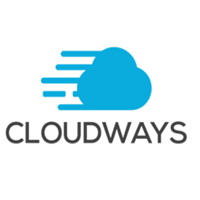Be it iOS vs. Android, Mac vs. Windows, or Chrome vs. Firefox, there are always two (or more) industry players competing with each other to give the best value to end-users. It's similar in the world of adtech.
Being a blogger myself, I have also tried my options hoping these tools will help improve my ad revenue as they promise. In this post, I'll share my experience with Ezoic and AdPushup一both are ad revenue optimization platforms; and why I chose to shift from Ezoic to AdPushup .
Both platforms have their strengths and limitations. I know a lot of fellow bloggers who use Ezoic. Well, I'm here to make my case for AdPushup explaining why I found it a better fit.
Note: This post is based on my personal experience and the use case may vary for different publishers.
AdPushup Vs Ezoic Comparison 2019: Which One Is Better?
Ease of Setup
AdPushup's revenue optimization platform helps in making high-conversion ad layouts using automated A/B testing. The suite of features also includes header bidding, innovative ad formats, ad mediation, adblock recovery, AMP converter, and Active View refresh ads.
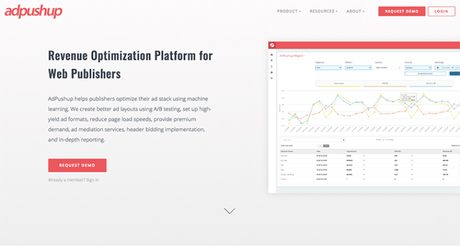
Ezoic claims to offer a similar value proposition. But AdPushup became my choice of partner because it is more user-centric, flexible, dependable, and most of all easy-to-use. I have used Ezoic for about four months, and while I did see a spike in my gross revenue, the overall experience did not work for me.
Not every publisher is tech savvy. In my experience after using multiple platforms, I can say the AdPushup keeps the layman user in mind. Getting started with Ezoic took me over a week, in contrast, setup took less than two days with AdPushup.
Ezoic requires Name Server Implementation during setup. This means you have to change your CNAME records and create a domain alias from the primary domain. For example, if your domain is abc.com, you'll need an alias, let's say, abc.net and point it to the main domain, abc.com.
Through this process, Ezoic gets unrestricted access to your entire website. The technical dependency on the CNAME change and the time it took did not seem worth. Either way, I had to continue once the setup was in place. On the contrary, AdPushup uses a basic JS Integration that requires a single line of code to be added in the website's header. In no time, AdPushup was up and running on my website.
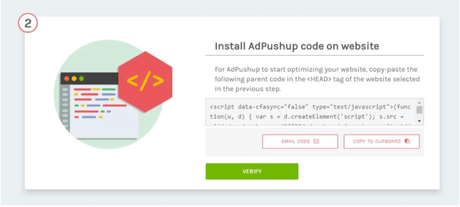
Although Ezoic also supports JS-based integration, they recommend going by the Name Server Implementation process. I don't understand why they insist on a more complex, less secure setup.
Image caption: Get started by inserting a JavaScript snippet in the <head> tag of your website.
Apart from the insistence on a DNS integration, Ezoic has been noticed to manipulate its A/B testing results to convince users that Ezoic provides a good revenue lift. One user on Reddit said the following :
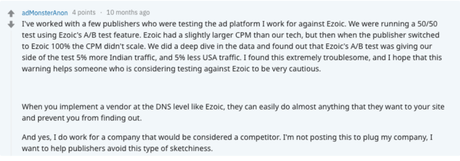
I'm not sure if this is an isolated incident, but for me, this kind of behavior counts as a huge red flag.
AdPushup Vs Ezoic: Comparison of Other Features
For me, setup is one of the most important parts of working with a new tech vendor. How easy or painful the setup process usually also indicates how the entire experience will be. But when your revenue is at stake, there are other things to consider as well.
In my experience, AdPushup is more demand agnostic. Based on publisher fit and requirements, they focus on either optimizing the AdSense account, setting up AdX and header bidding, or both. AdPushup treats all demand partners (including my AdSense) equally and sends the traffic to the better performing demand partner. Ezoic, on the other hand, focuses on generating revenue through AdX and header bidding.
Ezoic users may notice that the platform does not optimize or incentivize their AdSense accounts. This may be fine for publishers already on AdX. However, some websites may be better off with only AdSense optimization, as the CPM model in AdX and header bidding may not be the best fit for them. It is also interesting to A/B test AdSense vs. AdX on Adpushup.
We can say that Ezoic is a more AdX-compatible platform, while AdPushup is good to have for both AdX and non-AdX publishers; knowing that not all AdSense publishers are active AdX publishers.
Ezoic shows EPMV ("earning per thousand visitors") as the primary metric in their reporting. They try to push this metric a lot, and while it is useful, the reporting system is otherwise pretty bare bones. I had a hard time comparing my existing metrics with their new metric.
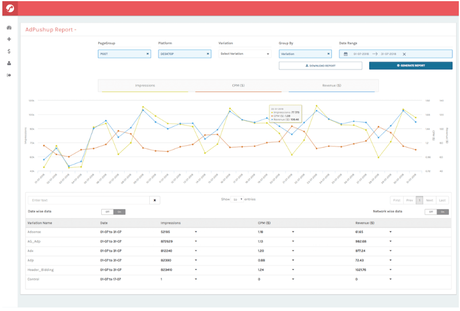
This metric was in beta in AdPushup reporting; so new publishers should be able to fully leverage that metric in some time. One thing Ezoic has going for itself is the Google Analytics integration, which is currently a manual process in AdPushup. However, AdPushup's reporting system has 9 dimensions and 8 filters while Ezoic has only two.
As a user, the extra reporting filters help me view custom reports based on exactly what I need to know. For instance, if I want to analyze demand partner performance, it's easy to create a network-wise revenue report in AdPushup. Fetching a use case-specific report is daunting in Ezoic.
One of AdPushup's strongest points according to me is their industry relationships and availability of the bring-your-own-demand option. Their demand network help publishers access over 50 demand partners and over 30,000 advertisers.
It has partnerships with top-tier networks and exchanges, including Google AdX, AppNexus, Rubicon, and Criteo, among others. They also help publishers onboard their existing demand partners to AdPushup platform. Ezoic also has some great partnerships to showcase. However, AdPushup's flexibility in being able to onboard existing demand partners gives it an upper hand here.
A do-it-yourself model might sound interesting. But with anything as complex as ad tech, users usually need human help at some point. For me, AdPushup aced their support game.
Their ad ops team is practically available 24×7 to solve any query. I was assigned a dedicated account manager who did all the legwork for me with utmost expertise一getting the setup ready, creating ad layouts, optimizing AdSense, sending performance reports, and advising whenever needed.
I don't have much to cover here for Ezoic. It is a self-service platform with limited support. I can't help but mention how important it is to receive help from an actual person when you're struggling with something.
Which is More Publisher-friendly?
In this section, I'll be highlighting some quick points describing my take on the user-friendliness of both the platforms.
<<Add carousel images with captions here>>UI and Friendliness: Both Ezoic and AdPushup offer dashboards to help publishers manage their ad stack, but AdPushup has a more publisher-friendly interface. I found the platform, especially the layout editor and reporting, easy-to-navigate and simple.
User Experience: Too many or mindlessly placed ads can affect the end user's experience. The ops team at AdPushup certainly holds expertise in creating the best, most effective ad layouts keeping the user experience in mind. In fact, I found a lot of publishers who are openly outraged stating that Ezoic affected their website layout and UX .
AdBlock Monetization: This means the ability to recover the ad revenue lost due to ad blockers. AdPushup's pro-user ad-reinsertion technology is unique among comparable solutions in the market. Most platforms including Ezoic do not offer this option as of now.
Data and Dependability: AdPushup provides header bidding partner- and ad network partner-wise revenue reports whereas Ezoic's reporting on the same is very basic. Also, in my experience, AdPushup never missed any payments, while there have been consistency issues with Ezoic.
Educational material: For publishers like me who loves to self-troubleshoot, AdPushup has a great that covers a lot of topics in the adtech space. Though Ezoic also has a comprehensive blog, for me it lacked the variety of topics, frequency, and coverage that the AdPushup blog has.
AdPushup Vs Ezoic: Pricing and Transparency
AdPushup follows a revenue-sharing model wherein they charge a certain revenue share from the publisher's overall revenue. Ezoic's subscription-based pricing model, on the other hand, raises some questions.
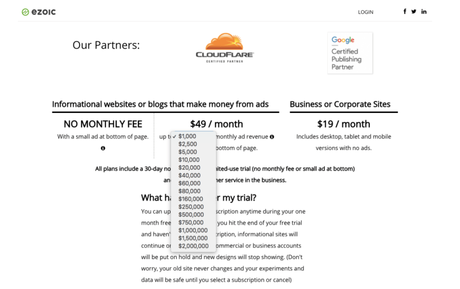
Ezoic's pricing is simply based on the publisher revenue slab. So what's the catch?
Case 1 → Publisher revenue = Up to $1000/mo | Pay amount to Ezoic = $49/mo
This is the base plan based on which Case 2 and 3 are calculated.
Case 2 → Publisher revenue = Up to $2500/mo | Pay amount to Ezoic = $124/mo
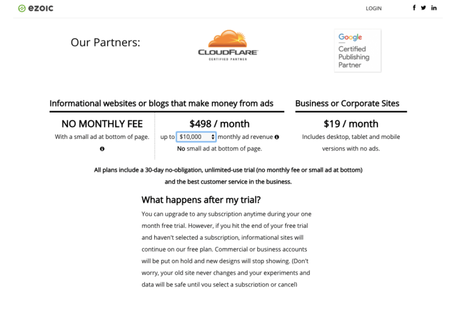
EXPLANATION: 150% increase in publisher revenue ($1000 to $2500) leads to 153.06% increase in publisher's price for Ezoic ($49 to $124). However, if a publisher's revenue is just $1500 (the publisher will still have to enter the $2500 slab), he/she is having just 50% increase in revenue, but yet has to bear a 153.06% higher cost, i.e., $124/mo for a website earning $1500/mo.
Case 3 → Publisher revenue = Up to $10,000/mo | Pay amount to Ezoic = $498/mo
EXPLANATION: 900% increase in publisher revenue (f$1000 to $10,000) leads to 916.33% increase in publisher's price for Ezoic ($49 to $498). However, if a publisher's revenue is just $7500 (the publisher will have to enter the $10,000 pricing slab), he/she is having a 650% increase in revenue but yet has to bear a 916.33% higher cost, i.e., $489 for a website earning $7500/mo.
Quick Links:
Final Take: AdPushup Vs Ezoic Comparison 2019 | Which One Is Better?
Taking both features and costing into account, I was able to make my switch from Ezoic to AdPushup. Value additions like a dedicated account manager, partner-wise custom reports, AdBlock recovery, and clear revenue sharing model compelled me to make the shift.
Recently, AdPushup released their version 2.0 after going through a product overhaul. The version has deeper reporting, ads.txt authenticator, AdSense unit automation, among other improvements. All these features make AdPushup a more robust revenue optimization platform for publishers.
You can explore how AdPushup works for you by getting started here .
